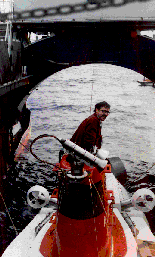jrobb@usgs.gov

This presentation for the Internet has been prepared using NCSA's (National Center for Supercomputing Applications, at the University of Illinois -- Urbana-Champaign) xmosaic and John Bradley's xv programs, and is served by ncsa-httpd. It can also be viewed, less conveniently, using other public-domain programs such as www or lynx.
Using xmosaic or equivalent World-Wide-Web browsers, the reader can follow various hypertext paths for explanations and images. I haven't been very imaginative to create labrynthine threads of sidebars here, and I think it's straightforward. To look at text explanations click on the highlighted text. To return to where you were, use the xmosaic "Back" button. Clicking on a highlighted reference will cause a jump to its position in the REFERENCES CITED file; again, use the "Back" button to return to the main text.
I have broken the text into its several files by section because short files transmit more conveniently. Transmission and display quickness is affected mostly by the image-files that have to be transported. In most places I use "thumbnail" images that you can click on to get the full-size image. It's a trade-off: the thumbnails come across the net much faster. In some cases I felt the in-text illustrations would be better bigger rather than tiny, thus to avoid need for immediate full-size retrieval, although the full-size illustrations remain accessible at the reader's choice.
Please keep in mind that in this medium there is no control of the readers' client capabilities. That is, what You see is created by Your machine. My files contain text and gif images; your machine supplies the fonts and the image viewer. There is no control by the author (or server) of fonts and font sizes or colors that the far-off viewer sees on his/her screen apart from some general classes provided by the web and html protocols. Similarly, the images will be better or worse for your viewing screen and viewing software. Quickness of the display process depends on the viewers' swap space and memory as well as on the "network bandwidth".
Incidentally, the html (hypertext markup language) that is this document's vehicle does not at this time have notation for degree symbols (or superscripts or subscripts)(or I haven't been able to unearth such a notation that works), so degree symbols in the titles and text do not display correctly. [Note: on 18May94, I have attempted to repair this notation using an iso8859-1 code. It might not work with your browser, but it works with my present Mosaic2.4 client.] Do not let minor irritation deter your enthusiasm for the World-Wide-Web, however. Features of the developing system are being improved and expanded by many workers, worldwide, even as you read.
Please send your comments to my e-mail address, below. Now click on "BACK" to continue.
Jim Robb 24 Feb 1994
jrobb@usgs.gov 
[an error occurred while processing this directive]